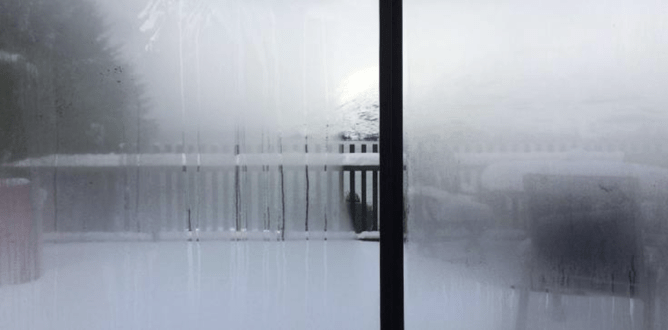When you bought your house, did you imagine looking through this at your incredible view? This photo was taken from our old home in Fernhill, Queenstown. I should be looking across Lake Wakatipu towards the mountains.
This is the price we are expected to pay when we use metal joinery in underheated homes….and this is the part you can see…….what do you think is happening at the other dew points which you can’t see?
Much of New Zealand housing stock has mould growing in the walls, this is because the dew point occurs in the fabric of the construction. The dew point is when water vapour, held in the air, condenses on a surface which is a lower temperature than the air. If not dealt with, the condensation combined with mould spores which are present in (amongst other things) dust, leads to a build-up of mould, which, in a lot of cases, is hidden in walls, degrading the fabric of the construction and insulation.
This doesn’t need to happen and it shouldn’t be happening in 2018. The temperature of a surface in your house should not be cold enough to cause moisture vapour to condensate. And humidity levels can be controlled.
Humans and human activity such as cooking, washing etc. produce high levels of indoor humidity. We are encouraged in New Zealand to get around this issue by opening lots of windows and increasing air movement (draughts) through natural ventilation.
So when it’s the winter, we are encouraged to create more draughts in our homes to get rid of excess moisture. We were already cold - and now we are told we need to be colder to stay healthy.....????
So what’s the answer?
- Increase the air temperature - heat your house properly. The World Health Organisation (WHO) recommends temperatures should be between 18°-21°
- Remove humidity at the source. Ventilate your house properly through mechanical means.
- Increase the thermal construction of your home so that the dew point occurs outside of the fabric. (i.e. don’t build to Building Code Minimums)
If you live in a house built to NZ Building Code minimum thermal requirements (in the Queenstown region), it is unlikely you will be able to heat your house to the recommended WHO temperature range without spending a fortune on heating or burning through a few mini forests.
If you use aluminium window joinery you will experience condensation on your windows. This is because when relative humidity is over 80%, the dew point temperature is 12.6°. Winter temperatures in our region can easily drop to -9°, so a material such as aluminium which can easily transfer the cold (cold bridging), will easily drop to 12.6°and below.
Passive House requires the internal surfaces to not be more than 3° below the ambient temperature. This means your choice over every part of the external fabric of your building needs to be considered with this in mind.
Balanced Heat Exchange Ventilation is a key part of creating a Passive House building. The system provides fresh clean indoor air quality completely different to anything we are used to in NZ housing. It is extremely low-velocity 0.2m/s and very low energy to run and relatively low cost to install (starting at $6,000). Continual fresh air is brought in and stale moist air is expelled at source (kitchens, laundries and bathrooms).
By building a better thermal envelope, you will have a much lower energy requirement to heat your home. Passive House buildings being 10x more efficient than Building Code minimum construction, so your heating is a tenth of the cost of a traditional kiwi build.
Even if you don’t want to go to the full Passive House Standard, the same technologies and detailing and thermal practices can be used, giving you a far superior internal environment and level of comfort.
Comfort doesn’t have to be a compromise - It’s your choice how far you go.

